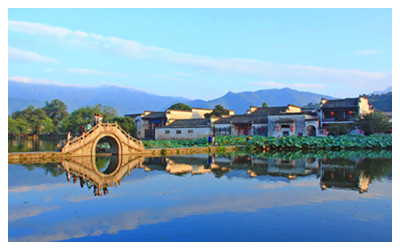Skype: neodalle-travel
Tel: +86 135 7447 2266
E-mail: sales@visitaroundchina.com

History of Hui-style Architecture
Hui architecture developed into a significant school in the Song Dynasty. During the middle period of the Ming Dynasty, gardens and houses constructed with Hui styles developed very quickly along with the Prosperity of Hui commerce and the development of its social economy. Hui style soon stepped out from Huizhou Prefecture and was introduced to big towns along the Yangtze River. The technical features and style of Hui architecture are mostly put into use in the construction of houses, ancestral temples, joss houses, archways, and gardens.
As a traditional architecture school, Hui style embodies elegance, conciseness, and magnificence, and still keeps its special artistic favor to this day.
Features of Hui-style Architecture
Hui style houses mainly reflect the mountainous features, geomantic omen, and the beautiful terrain there. Due to the rolling hills and streaming rivers, the villages are usually located near water, or lined up with the hillside along the contour. Winding alleys stretch between high and low houses, and a limpid pool clearly mirrors the buildings and trees lined up beside it.
Hui style houses are typically ones with skylights. With a quadrate skylight surrounded by houses from four sides or from left, right and backside, these Hui style houses can reduce the beat of sunshine and enjoy ventilation. All the houses drain off water to the skylight which means fortune will not run off outside, which is called "four sides water returning to the main hall of the houses" by local natives.
Where to see Hui-style Architecture
At the foot of picturesque Huangshan Mountain sprawl clusters of grey-tiled and white-walled houses, forming the most typical scene captured in traditional Chinese landscape paintings. Huizhou-syle Dwelling is popular in south Anhui Province and north Jiangxi Province.Their townscapes are developed in harmony with the natural environment, using the geomantic principles of Feng Shui. Therefore, most ancient villages are set up against mountains and facing waters. It is believed to bring good luck to all villagers. In fact, this brought about convenience both to living and to farming for the villages. Furthermore, the village is segmented by winding and narrow lanes. The Huizhou-style Dwelling is the predominant architecture in the villages: white walls, dark tiles, horse-head gables, stone drums or mirrors and open interior courtyards are common features.
Nanping Village Tangmo Ancienrt Village Ask Questions ?
Ask Questions ?